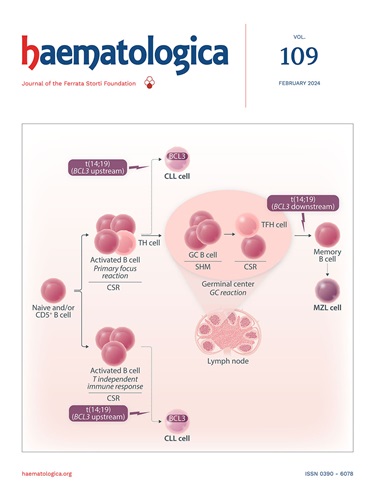血小板驱动的单核细胞活化通过HIF-1α-NLRP3-EGR-1轴促进缺氧血栓炎症。
IF 7.9
1区 医学
Q1 HEMATOLOGY
引用次数: 0
摘要
缺氧通过NLRP3炎性小体加重血栓栓塞和无菌性炎症,NLRP3炎性小体被HIF-1α直接激活,而HIF-1α在加深深静脉血栓形成(DVT)中起关键作用。血栓炎症的临床表现之一是深静脉血栓,其特征是在身体的下肢形成和传播血栓。潜在的炎症环境促进免疫细胞募集和血小板过度活化,进一步促进血栓形成前状态。然而,缺氧、血栓栓塞和无菌性炎症之间的复杂关系尚不完全清楚。为了解决这一知识缺口,我们整合了体外细胞系、离体人原代血单个核细胞(hPBMCs)、体内动物模型和基于人类患者的研究,以揭示细胞相互作用在驱动缺氧诱导血栓形成中的作用。我们确定了早期的机制见解,随后测试了在高海拔地区(海拔11000英尺)发生深静脉血栓的人类样本的转化潜力。我们的研究表明,缺氧通过CD11a/CD18 (β2整合素)和F11R(连接粘附分子-1;JAM-1)介导,增加了单核细胞对内皮表面的粘附。我们发现HIF-1α- NLRP3- egr1 - tf /FVII轴在无菌条件下通过NLRP3升高Egr-1在炎症诱导凝血中的作用,从而增加组织因子。这条轴增加血小板过度活化和血小板关联,放大血栓炎症。发生高原血栓形成的人类患者显示HIF-1α、NLRP3、Egr1和TF/FVII水平升高,证实了临床相关性。最后,用药理学抑制剂或sirna去除这些分子已经证明了逆转这些病理生理过程的潜力。这些发现确定HIF-1α-NLRP3-Egr1-TF/FVII轴是缓解缺氧诱导的血栓炎症的潜在治疗靶点。本文章由计算机程序翻译,如有差异,请以英文原文为准。
Platelets-driven monocyte activation promotes hypoxic thromboinflammation through the HIF-1α-NLRP3-EGR-1 axis.
Hypoxia exacerbates thromboembolism and sterile inflammation through NLRP3 inflammasome, which is directly activated by HIF-1α that plays a pivotal role in potentiating deep vein thrombosis (DVT). One of the clinical manifestations of thromboinflammation is DVT, characterized by formation and propagation of clot in the lower extremity of the body. The underlying inflammatory milieu promotes immune cell recruitment and platelet hyperactivation, further promoting a prothrombotic state. However, the intricate relationship between hypoxia, thromboembolism, and sterile inflammation is not fully understood. To address this knowledge gap, we integrated in vitro cell lines, ex vivo human primary blood mononuclear cells (hPBMCs), in vivo animal models, and human patient-based studies to uncover the role of cellular interactions in driving hypoxia-induced thrombosis. We identified the early mechanistic insights and subsequently tested the translational potential in human samples who developed DVT at high altitudes (altitude >11,000 feet). Our investigation revealed that hypoxia increased monocyte adhesion to endothelial surface, mediated through CD11a/CD18 (β2 integrin) and F11R (Junctional adhesion molecule-1; JAM-1). We identified the significance of the HIF-1α- NLRP3-Egr1-TF/FVII axis in inflammation-induced coagulation under sterile conditions operating through NLRP3 elevating Egr-1, which subsequently augments tissue factor. This axis increases platelet hyperactivation and platelets' association amplifying thromboinflammation. Human patients who developed high altitude thrombosis revealed enhanced HIF-1α, NLRP3, Egr1, and TF/FVII levels, confirming clinical relevance. Finally, abrogating these molecules either with pharmacological inhibitors or siRNAs have demonstrated a potential to reverse these pathophysiological processes. These finding identify the HIF-1α-NLRP3-Egr1-TF/FVII axis as a potential therapeutic target for mitigating hypoxia induced thromboinflammation.
求助全文
通过发布文献求助,成功后即可免费获取论文全文。
去求助
来源期刊

Haematologica
医学-血液学
CiteScore
14.10
自引率
2.00%
发文量
349
审稿时长
3-6 weeks
期刊介绍:
Haematologica is a journal that publishes articles within the broad field of hematology. It reports on novel findings in basic, clinical, and translational research.
Scope:
The scope of the journal includes reporting novel research results that:
Have a significant impact on understanding normal hematology or the development of hematological diseases.
Are likely to bring important changes to the diagnosis or treatment of hematological diseases.
 求助内容:
求助内容: 应助结果提醒方式:
应助结果提醒方式:


